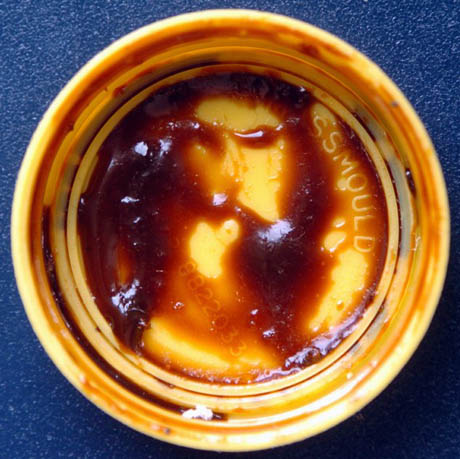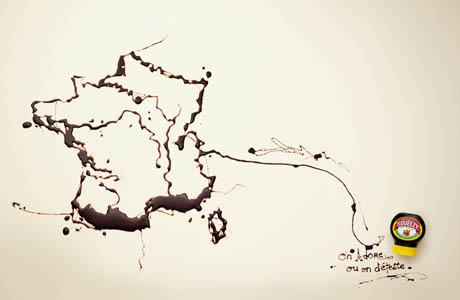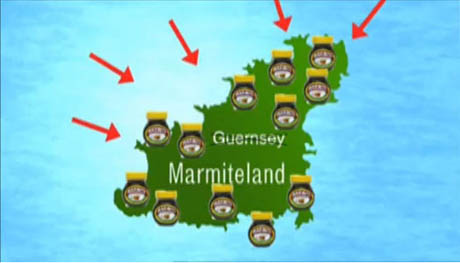Marmite, the brewing by-product turned British toast-topper, has turned up in a couple of interesting contexts lately due to its “Love it or hate it” ad campaign. Although the tagline was first used in 1996 (replacing “My Mate, Marmite”), it has recently achieved recognition as a snowclone.

IMAGE: Last year, Claire Allen claimed to find Jesus in the lid of a Marmite jar.
A snowclone, according to linguistics professor Geoffrey Pullum, is “a multi-use, customisable, instantly recognisable, time-worn, quoted or misquoted phrase or sentence that can be used in an entirely open array of different variants,” or, in somewhat a less technical terms, a “some-assembly-required adaptable cliché frame for lazy journalists.” It’s one of those expressions, like the equally gorgeous “crash blossom,” that I didn’t even realise how much I needed until I read the definition.

IMAGE: George W. Bush in Marmite, from the “Love it or hate it” campaign, via.
The word “snowclone” was coined by economist Glen Whitman in response to one of Geoffrey Pullum’s examples of swappable template phrases: that if the Eskimo have more than a hundred words for snow, the [insert a group here] must have even more for [insert a thing here]. For example, if the Eskimo have more than a hundred words for snow, the British must have even more for rain; and if the Eskimo have more than a hundred words for snow, the Italians must have even more for pasta. (The fact that the Inuit language has “about the same number of distinct word roots referring to snow as English does,” according to Wikipedia, is neither here nor there.)
There are now 382 accredited examples in the snowclone database, from the basic (“X is the new Y”) to the more enjoyably esoteric (“X me no Xs,” “I am X, hear me Y,” and “In X, no one can hear you Y”). The only other snowclone of edible origin (if you discount Inuit snow), is “Got X?,” from the 1993 California Milk Processors Board ad, whose variations range from the religious (“Got Jesus?“) to the chiropractic (“Got Subluxation?“).

IMAGE: Marmite’s love/hate geography, from their advertising series, via.

IMAGE: Marmite’s love/hate geography, from their spoof “Hate party” manifesto proposal to exile Marmite lovers to Guernsey, via.
Marmite’s inclusion in the snowclone list rests on the template phrase “X is the Marmite of Y,” which is sometimes spelled out more clearly as “X is like Marmite—you either love it or you hate it.” According to the editors of the Guardian‘s style guide, Marmite rose to snowclone status soon after the launch of its new squeezy format in March 2006. Since then, there have been 119 Marmite comparisons in the paper, including, in just the last couple of months, architect Renzo Piano’s Central St. Giles (“It’s also a Marmite building, which passers-by either hate or love”) and designer Ron Arad (“He’s the design equivalent of Marmite”). At this point, Marmite analogies have apparently overtaken the previously ubiquitous “elephant in the room” in Guardian bingo.

IMAGE: Screenshot of the spoof Marmite “Hate party” broadcast, via.

IMAGE: Screenshot of the BNP party broadcast, complete with levitating Marmite jar, via.
In the last couple of days, the clarity and brash self-confidence of Marmite’s “love it or hate it” stance has also been appropriated by politicians, not just lazy journalists. On the same morning that Gordon Brown tweeted that he loves marmalade but his wife loves Marmite, Unilever (who own the Marmite brand) began legal proceedings against the far-right, racist British National Party for unauthorised use of Marmite in a party political broadcast:
It has been brought to our attention that the British National Party has included a Marmite jar in a political broadcast shown currently online. We want to make it absolutely clear that Marmite did not give the BNP permission to use a pack shot of our product in their broadcast. […] We are currently initiating injunction proceedings against the BNP to remove the Marmite jar from the online broadcast and prevent them from using it in future.
The rogue Marmite jar can be seen floating rather surreally to the left of Nick Griffin’s head, above a British passport, a case of framed medals, and a set of weighty tomes worthy of a Restoration Hardware catalogue, in one of the more peculiar examples of TV set design. Somewhat incredibly, the BNP claims that they did not insert the Marmite jar themselves (it was put in there without permission by “one of the people to whom we had given the broadcast to review”), but that in any case, it’s fair revenge for Marmite’s own spoof ad campaign, in which the “Hate party” leader asks followers to “Stop the spread” from a similarly decorated room. No word as yet from Nick Clegg or David Cameron on their position on Marmite…

IMAGE: The political implications of food preferences and references, photo via.
Ridiculous as the BNP and its attempt at a viral marketing Marmite-hijack are, the significance of food choices in a political campaign are always interesting. Barack Obama’s arugula slip during a campaign stop in Iowa led to much media debate over “wine-track” versus “beer-track” Democrats; meanwhile, this year’s tightly contested New York state elections are being fought on the plate as well as the campaign trail, according to the New York Times. As French gastronomer Jean Anthelme Brillat-Savarin presciently noted, back in 1825, “Tell me what you eat, and I will tell you who you are.”
Discover more from Edible Geography
Subscribe to get the latest posts to your email.